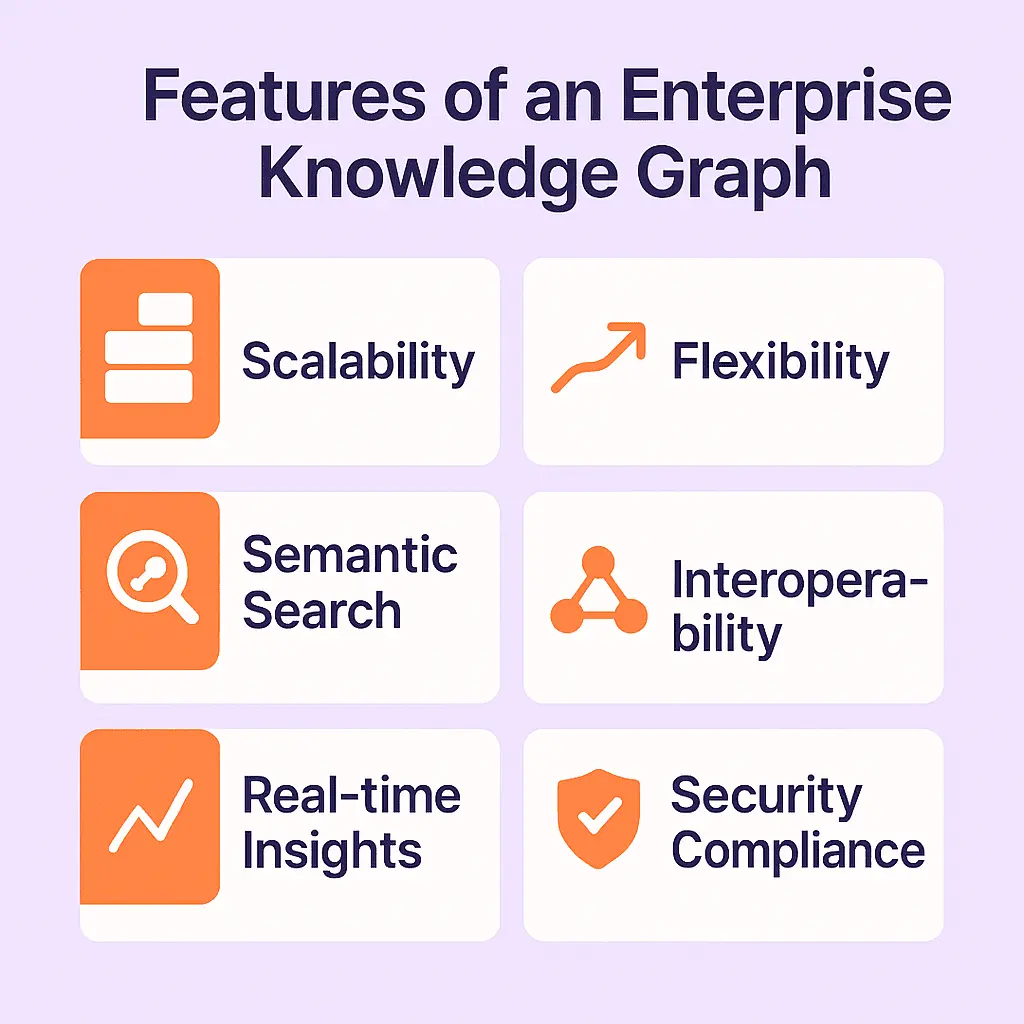In the fast-evolving landscape of artificial intelligence, organizations are under constant pressure to innovate, automate, and optimize. Despite the proliferation of AI tools and techniques, many enterprises struggle to bridge the gap between data silos and actionable insights. Enter the Enterprise Knowledge Graph — a powerful framework that acts as the missing link in successful AI transformations.
What is an Enterprise Knowledge Graph?
An Enterprise Knowledge Graph (EKG) is a structured representation of an organization’s knowledge, integrating data from diverse sources into a unified, semantically rich model. By mapping relationships between entities (like people, products, processes, and places), EKGs enable machines to understand, reason, and derive insights in a human-like manner.

Unlike traditional databases, which are typically schema-bound and rigid, EKGs are dynamic, flexible, and inherently designed to evolve with the enterprise. They use ontologies and taxonomies to create meaning from data, making them ideal for powering AI systems with contextual intelligence.
Why Enterprise Knowledge Graphs are Crucial for AI Transformation
1. Breaking Down Data Silos
Modern enterprises generate data at an unprecedented scale, often stored across disparate systems — CRM, ERP, data lakes, spreadsheets, and more. EKGs act as a connective tissue, linking these isolated data sources to provide a 360-degree view of the enterprise.
2. Contextual Understanding for AI
AI systems thrive on context. Without understanding the relationships between data points, even the most sophisticated algorithms can misinterpret information. EKGs embed contextual metadata, enabling AI to make more accurate and relevant decisions.
3. Enabling Explainable AI (XAI)
Transparency in AI decision-making is a growing concern, especially in regulated industries like finance and healthcare. EKGs make AI decisions traceable by providing clear lineage and relationship paths, thus enabling explainable AI.
4. Accelerating Natural Language Processing (NLP)
Knowledge graphs boost NLP applications by providing a semantic layer that enhances entity recognition, disambiguation, and intent detection. This leads to more accurate chatbots, virtual assistants, and content recommendation engines.
5. Empowering Personalized Experiences
With a robust Enterprise Knowledge Graph, organizations can deliver hyper-personalized experiences by understanding user preferences, behavior patterns, and contextual data in real-time.
Real-World Applications of Enterprise Knowledge Graphs
Healthcare
In healthcare, EKGs link patient records, clinical trials, research papers, and drug databases, enabling AI to identify treatment pathways, drug interactions, and patient risk profiles with unprecedented accuracy.
Finance
Financial institutions use knowledge graphs to detect fraud, streamline compliance, and analyze market trends by integrating structured and unstructured data from trading platforms, news sources, and regulatory databases.
Manufacturing
In manufacturing, EKGs connect data from supply chain systems, IoT devices, and maintenance logs to predict equipment failures, optimize production schedules, and enhance quality control.
Retail
Retailers leverage knowledge graphs to unify customer data, inventory systems, and marketing analytics, facilitating personalized promotions, improved product recommendations, and better demand forecasting.
Building an Enterprise Knowledge Graph: Key Components
1. Data Integration Layer
The foundation of an EKG is seamless data ingestion from both internal and external sources. This includes APIs, databases, file systems, and web data.
2. Semantic Layer
This layer consists of ontologies and vocabularies that define the meaning and relationships between entities. Standards like RDF, OWL, and SKOS play a crucial role here.
3. Graph Database
Purpose-built graph databases like Neo4j, Amazon Neptune, or Stardog store and query the knowledge graph efficiently, enabling real-time data exploration.
4. Inference Engine
An inference engine applies logical rules to infer new knowledge from existing data, enabling reasoning capabilities that support advanced AI use cases.
5. Access and Governance
Role-based access control, data lineage tracking, and compliance frameworks ensure that the EKG is secure, auditable, and aligned with enterprise data governance policies.
Working of an Enterprise Knowledge Graph
- Data Ingestion: Extract, transform, and load (ETL) data from internal systems (ERP, CRM) and external sources.
- Entity Resolution: Identify and merge different references to the same real-world entities across datasets.
- Ontology Mapping: Define concepts and relationships using ontologies that align with business logic.
- Graph Construction: Build the graph using a graph database, where nodes represent entities and edges represent relationships.
- Enrichment & Inference: Add metadata and use reasoning engines to derive new facts and insights.
- Query & Visualization: Enable access through SPARQL queries or user-friendly visualization tools for exploration.
Features of an Enterprise Knowledge Graph
- Scalability: Handles massive, heterogeneous datasets.
- Flexibility: Easily adapts to evolving data schemas and business needs.
- Semantic Search: Enables intelligent, context-aware search across enterprise data.
- Interoperability: Integrates with AI, ML, and BI tools seamlessly.
- Real-time Insights: Supports dynamic querying and live updates.
- Security & Compliance: Built-in mechanisms for data governance and regulatory adherence.

Use Case Scenarios
- Customer 360: Combine CRM, support, and behavioral data to understand the complete customer journey.
- Regulatory Compliance: Map regulations to business processes for continuous compliance monitoring.
- Intelligent Supply Chain: Predict demand, assess risk, and optimize logistics using interconnected supply data.
- AI Model Training: Feed consistent, contextual data into ML models to improve prediction accuracy.
- Knowledge Discovery: Unearth hidden connections across documents, emails, and enterprise systems.
Best Practices for Implementing an Enterprise Knowledge Graph
- Start with a Clear Use Case: Identify high-value areas where contextual intelligence can drive impact, such as customer service or fraud detection.
- Engage Domain Experts: Collaborate with subject matter experts to build accurate ontologies and ensure the semantic layer reflects real-world knowledge.
- Iterative Development: Adopt an agile approach, starting with a minimum viable graph and iteratively expanding it based on feedback and performance.
- Ensure Interoperability: Use open standards and APIs to ensure the EKG can integrate with existing enterprise systems and AI platforms.
- Focus on Data Quality: Poor-quality data can undermine the effectiveness of your EKG. Implement robust data cleansing, validation, and enrichment processes.
The Future of Enterprise Knowledge Graphs
As AI matures, the role of the Enterprise Knowledge Graph will become even more pivotal. With the rise of generative AI, EKGs are being used to ground large language models (LLMs), improving factual accuracy and domain relevance. They also enable real-time reasoning, contextual search, and dynamic data storytelling.
Furthermore, as organizations move toward data mesh architectures, EKGs provide the semantic fabric that links decentralized data products, fostering a more connected and intelligent enterprise.
Conclusion
The Enterprise Knowledge Graph is not just another data management tool — it is a strategic asset that transforms how organizations leverage AI. By connecting the dots across systems, surfacing hidden insights, and enabling smarter decisions, EKGs unlock the full potential of AI transformation.For organizations aiming to lead in the era of intelligent automation, investing in an Enterprise Knowledge Graph is not optional — it’s essential.
FAQ
EKGs are valuable across industries such as healthcare, finance, retail, manufacturing, telecom, and legal, where complex relationships and large volumes of data require contextual understanding.
Timelines vary by scope and complexity, but organizations typically see initial results within 3-6 months using agile, use-case-driven approaches.
Yes, EKGs enrich AI models by supplying clean, structured, and contextual data, improving accuracy and reducing bias.
Yes, tools like RDF4J, Apache Jena, and GraphDB offer open-source support for building semantic graphs. Commercial options provide enterprise-grade features.
Data privacy is maintained through access controls, encryption, audit trails, and compliance with regulations such as GDPR and HIPAA.



